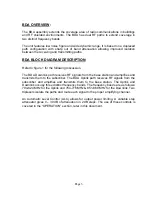
BDA OVERVIEW:
The BDA assembly extends the coverage area of radio communications in buildings
and RF shielded environments. The BDA has dual RF paths to extend coverage in
two distinct frequency bands.
The unit features low noise figure and wide dynamic range. It is based on a duplexed
path configuration with sharp out of band attenuation allowing improved isolation
between the receiving and transmitting paths.
BDA BLOCK DIAGRAM DESCRIPTION:
Refer to figure 1 for the following discussion.
The BDA Downlink path receives RF signals from the base station and amplifies and
transmits them to the subscriber. The BDA Uplink path receives RF signals from the
subscriber and amplifies and transmits them to the base station. The Uplink and
Downlink occupy three distinct frequency bands. The frequency bands are as follows:
794-824 MHz for the Uplink and 764-776 MHz & 851-869 MHz for the Downlink. Two
triplexers isolate the paths and route each signal to the proper amplifying channel.
An Automatic Level Control (ALC) allows for output power limiting. A variable step
attenuator gives 0 – 30 dB of attenuation in 2 dB steps. The use of these controls is
covered in the “OPERATION” section, later in this document.
Page 3


























